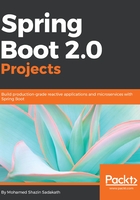
Summary
Congratulations on completing the first chapter. This chapter talked about what Spring Boot is, and explained its unique characteristics in depth by talking about Spring Boot's standalone, production-grade, flexible, and extensible capabilities in detail with examples.
Also, it talked about how to get started with Spring Boot application development by going through the anatomy of a Spring Boot application. It explained what makes a Spring Boot application different from a standard Maven Java application. Also, it talked about the ways a Spring Boot application can be run.
Next, it talked about what has changed from Spring Boot 1.x to Spring Boot 2.0, as it is a major version release, and how to successfully migrate from Spring Boot 1.x to Spring Boot 2.0 by going through each change and explaining how it affects an existing Spring Boot application. It also covered how to mitigate any adverse effects successfully without breaking the application.
Furthermore, it talked about what is in the pipeline for the next minor release of Spring Boot 2.0. These are enhancements that are proposed and discussed by the Spring Boot community, which they deem necessary for the next minor release. These features, along with more features, enhancements, and bug fixes, can be expected in the next minor release, Spring Boot 2.1.0.
This chapter has set the pace for coming chapters, which contain more exciting, hands-on Spring Boot 2.0 applications. The contents of this chapter will help greatly in upcoming chapters when it comes to understanding what makes a Spring Boot application work. This chapter also touched on different parts of the Spring Framework ecosystem such as Spring Security, Spring Data JPA, and so on, which will be covered in detail in coming chapters. This chapter has enabled us to write Spring Boot 2.0 applications that just run easily and effectively.